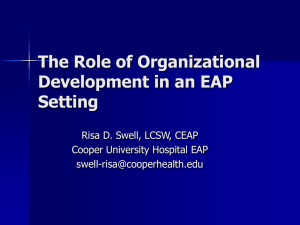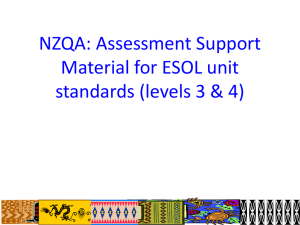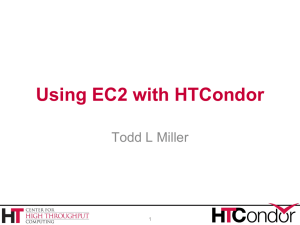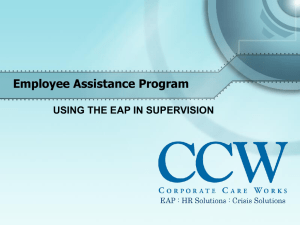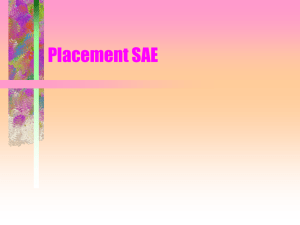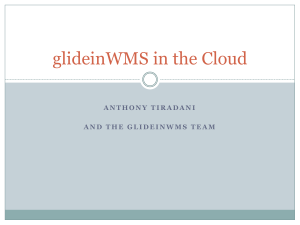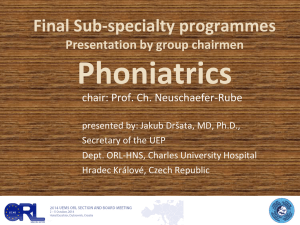Early Assessment Program: A Valid Solution for
advertisement
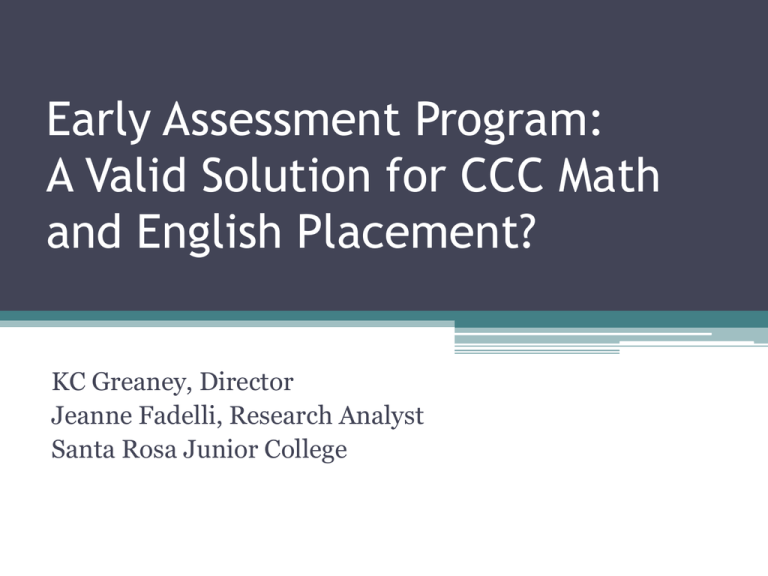
Early Assessment Program: A Valid Solution for CCC Math and English Placement? KC Greaney, Director Jeanne Fadelli, Research Analyst Santa Rosa Junior College EAP Background • Developed by the California State University as an early alert system, with the goal of minimizing remediation • Administered in conjunction with statewide STAR testing in April of the junior year of high school • Math and English only • Optional for students EAP: CSU’s Stated Goal “The goal of the EAP program is to have California high school graduates enter the CSU fully prepared to begin college-level study.” EAP English • Includes multiple choice questions and a writing sample • Results: students are deemed either 1. “ready for college level work,” or 2. “not yet ready” • A designation of “ready” places students into Freshman composition at any CSU • No need for students to take CSU placement test EAP Math • Includes multiple choice questions including some in addition to the STAR test • Results: students are deemed either 1. “ready for college level work,” or 2. “not yet ready,” or 3. “ready for college level work – conditional” • Students deemed conditionally ready are advised to take math coursework during senior year in order to become “ready” • A designation of “ready” places students into college level, non-remedial math courses at any CSU Statewide EAP Results • 378,870 students took English EAP in 2010 ▫ 21% demonstrated readiness • 178,667 students took math EAP in 2010 ▫ 15% “ready for college level work” ▫ 42% “conditionally ready” ▫ 43% “did not demonstrate readiness” Source: CSU Communication of EAP Results • Students receive results in conjunction with STAR test results in August prior to senior year of high school • Students can access their individual scores, and advice, online at CSU EAP website • EAP results (statewide, by county, by district, by school) are available from CSU EAP website: www.calstate.edu/eap • Plans for individual student EAP results to be directly accessible by CCC’s So, what does this have to do with California Community Colleges? • Senate bill 946 (Scott) passed in 2008 ▫ “This bill enables community colleges to work with their local high schools and CSU, through the EAP, to address the high number of students who are unprepared for college-level course work.” • Pressure also from research institutes, other governmental agencies, and to some degree the public • There is now an EAP division at the CCCCO: http://www.cccco.edu/ChancellorsOffice/Divisions/StudentServices/Early AssessmentProgram/tabid/1610/Default.aspx Benefits to Using EAP Scores for Placement at CCC’s • Results are portable • Students receive early warning of potential need for remediation • Minimizes number of tests students must take • Minimizes number of assessment tests CCC’s must administer ▫ Potential cost savings • Attempt to align K-12 standards with college coursework Challenges to Using EAP Scores for Placement at CCC’s • Results are limited ▫ English: College ready or not ▫ Math: College ready, conditionally ready, or not • Community College Math and English pathways are long ▫ EAP cannot place into more than one level • If students are not deemed “college ready” they will still need to take local CCC assessment test(s) to enroll at local community colleges Challenges to Using EAP Scores for Placement at CCC’s (continued) • Implementation issues ▫ Are EAP results equivalent to an assessment score? Or do students petition to have prerequisite waived, using EAP scores as justification? ▫ How to deal with students who were deemed “conditionally ready” in math? Do they need to show proof they took math senior year? Who reviews? Case Study: SRJC • Began accepting EAP results for placement in 2009 • Current practice: students petition for pre-requisite equivalency citing EAP results as justification ▫ Students deemed “conditionally ready” in math must bring proof of senior year math achievement ▫ Conditional math petitions are approved by math department • Pending practice: EAP results are entered into student files as placement test scores ▫ Conditionally ready math students still must petition • SRJC’s Research Office Received modest CCCCO EAP grant to build infrastructure and to conduct research Questions at SRJC • What is the profile of EAP students at SRJC? • How well does the EAP function as a placement tool at SRJC? • How do students and faculty rate the efficacy of placement? • How do the grades compare for students who place via EAP versus other students? EAP Placements at SRJC, Fall 2010 English Math # petitions submitted 63 28 # petitions approved 63/63 (100%) 20/28 (71%) # enrolled in subject course in Fall 2010 53/63 (84%) 13/20 (65%) Notes: •Total number of petitions filed =91 •Headcount of petitioners = 78 (13 students filed petitions for both English and math) •Math petitions denied for the following reasons •Conditional students did not complete recommended math coursework in senior year •Lack of documentation •Petition requested placement into a course not justified by the EAP Profile of EAP Students at SRJC • Gender ▫ 49% female ▫ 51% male • Educational Status ▫ 92% new student ▫ 5% concurrently enrolled student (95% have high school diploma or equivalent) ▫ 1% continuing student ▫ 1% new transfer student Note: n=91 Profile of EAP Students at SRJC • Ethnicity ▫ ▫ ▫ ▫ ▫ 78% White 22% Latino 2% Asian 1% Black 1% American Indian Notes: • Students could mark more than one ethnicity • Gender and ethnicity generally mirror SRJC student population Preliminary Outcomes of EAP Students Successful EAP Petitioner SRJC Average Average # units completed as of 9/1/10 2.30 n/a SRJC GPA as of 9/1/10 3.47 2.75 Units enrolled Fall 2010 12.93 11.29 Notes: •EAP students generally have successfully completed prior coursework at SRJC, either as a concurrently enrolled high school student or the summer after graduating high school •EAP students post higher GPAs and enroll in more units than the average SRJC student Enrollment of EAP Students in Fall 2010 Course Enrollment ENGL1A (freshman composition) 51 Other English courses (2 total) 2 English sub-total 53 % of successful English petitioners who enrolled 84% (53 out of 63) MATH27 (college algebra & trigonometry) 6 Other math classes (6 total) 7 Math sub-total 13 % of successful math petitioners who enrolled 65% (13 out of 20) EAP Student Satisfaction with Placement: English 1A • Self-rating of academic preparedness ▫ 5.1% (n=3) unprepared ▫ 78.0% (n=46) somewhat to fully prepared ▫ 16.9% (n=10) overprepared • Self-rating of accuracy of placement ▫ 1.7% (n=1) should be in lower level course ▫ 79.7% (n=47) belong in course ▫ 18.6% (n=11) should be in higher level course EAP Student Final Grades, Fall 2010 English 1A Math 27 EAP student GPA 3.31 (n=48) 2.17 (n=6) Overall student GPA 2.58 (n=2025) 2.23 (n=266) % of EAP students who dropped/withdrew from the class 6% (n=3) 0% (n=0) Overall % of students who dropped/withdrew from the class 19% (n=384) 19% (n=50) Summary • The typical EAP student enrolling at SRJC in Fall 2010 is a high achieving high school graduate enrolling as a new student at SRJC the fall after high school graduation • This typical student has already completed some coursework at SRJC and posts a higher SRJC GPA than the average SRJC student, and is enrolled full time. Conclusion • Preliminary results show that, at least for placement into Freshman Composition at SRJC, the EAP appears to function effectively as a placement test as evidenced by preliminary consequential and criterion-based analyses
